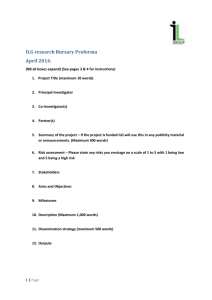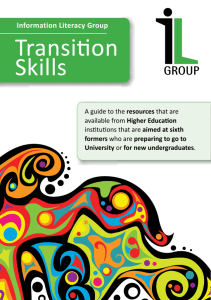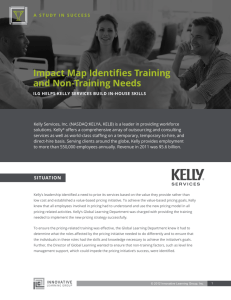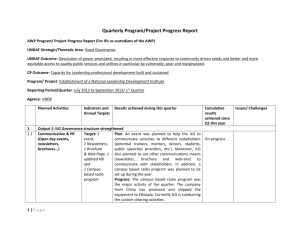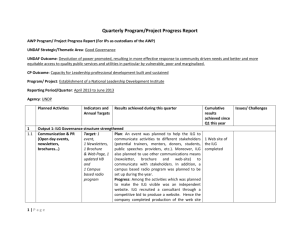Appendix 1 - Information Literacy
advertisement
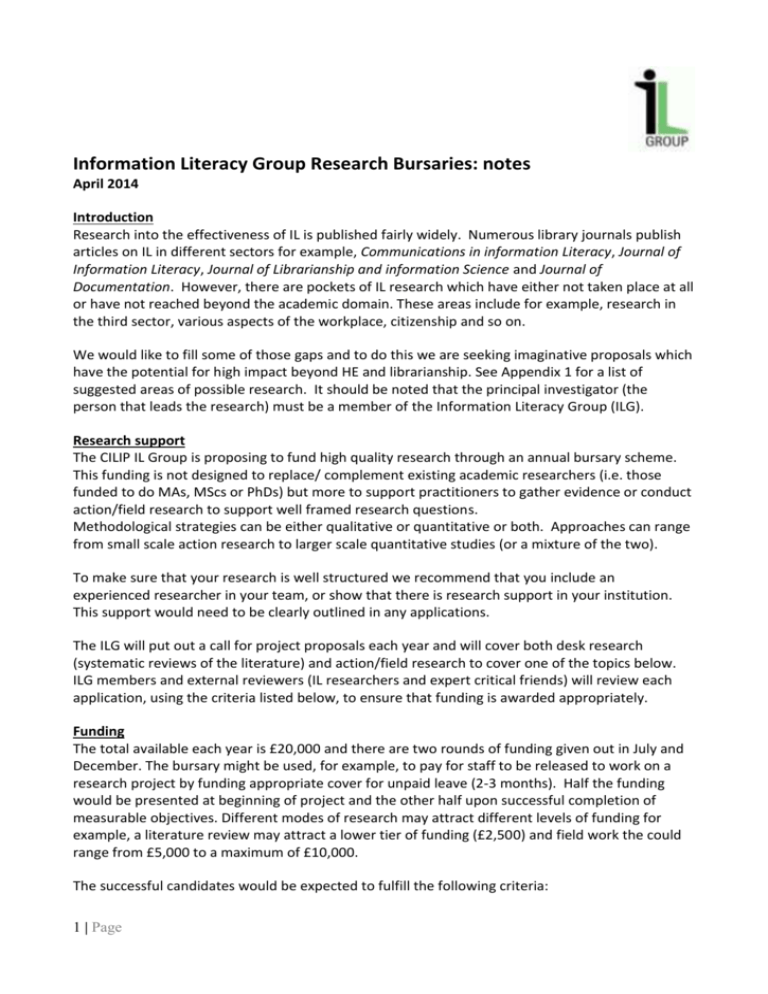
Information Literacy Group Research Bursaries: notes April 2014 Introduction Research into the effectiveness of IL is published fairly widely. Numerous library journals publish articles on IL in different sectors for example, Communications in information Literacy, Journal of Information Literacy, Journal of Librarianship and information Science and Journal of Documentation. However, there are pockets of IL research which have either not taken place at all or have not reached beyond the academic domain. These areas include for example, research in the third sector, various aspects of the workplace, citizenship and so on. We would like to fill some of those gaps and to do this we are seeking imaginative proposals which have the potential for high impact beyond HE and librarianship. See Appendix 1 for a list of suggested areas of possible research. It should be noted that the principal investigator (the person that leads the research) must be a member of the Information Literacy Group (ILG). Research support The CILIP IL Group is proposing to fund high quality research through an annual bursary scheme. This funding is not designed to replace/ complement existing academic researchers (i.e. those funded to do MAs, MScs or PhDs) but more to support practitioners to gather evidence or conduct action/field research to support well framed research questions. Methodological strategies can be either qualitative or quantitative or both. Approaches can range from small scale action research to larger scale quantitative studies (or a mixture of the two). To make sure that your research is well structured we recommend that you include an experienced researcher in your team, or show that there is research support in your institution. This support would need to be clearly outlined in any applications. The ILG will put out a call for project proposals each year and will cover both desk research (systematic reviews of the literature) and action/field research to cover one of the topics below. ILG members and external reviewers (IL researchers and expert critical friends) will review each application, using the criteria listed below, to ensure that funding is awarded appropriately. Funding The total available each year is £20,000 and there are two rounds of funding given out in July and December. The bursary might be used, for example, to pay for staff to be released to work on a research project by funding appropriate cover for unpaid leave (2-3 months). Half the funding would be presented at beginning of project and the other half upon successful completion of measurable objectives. Different modes of research may attract different levels of funding for example, a literature review may attract a lower tier of funding (£2,500) and field work the could range from £5,000 to a maximum of £10,000. The successful candidates would be expected to fulfill the following criteria: 1 | Page ● produce a project plan with milestones and simple Gantt chart in accordance with ILG funders' deadlines (this is to reassure the reviewers that you have a realistic idea of how the project will be achieved). ● You should include a stakeholder analysis in your project plan and a risk assessment statement. ● produce a clear plan with SMART objectives (specific, measurable, achievable, relevant and timely) that meet funders' criteria. ● demonstrate how the research will be disseminated (See Appendix 2 for examples of what a well thought out strategy might include) ● Provide an evaluation strategy. This is to ensure that you have thought about how the project is progressing and meeting your aims and objectives ● release any outputs using Creative Commons licences either through CoPILOT, Jorum or another appropriate location (this is to make sure that any outputs can be used by the widest possible audience) Criteria Proposals are more likely to receive funding if they contain the following: ● A well thought out methodology ● A clear project plan, objectives and milestones ● An effective dissemination strategy ● An evaluation strategy ● A stakeholder analysis and a risk assessment statement ILG funders are particularly seeking to fund projects that: ● demonstrate collaboration between sectors ● have tangible, practical benefits (i.e. produces a new process or product with potential application beyond education) ● address current issues affecting areas outside of librarianship (see Appendix1) ● show potential for further large scale study, dissemination and exploitation 2 | Page Appendix 1 Key areas of policy or concern These are some of the areas that the ILG have identified as key areas of policy or concern and, therefore, potential areas of research. These are meant as suggestions only and it is not an exhaustive list. The role and impact (or lack of role and impact and how to remedy it) of IL on: ● ● ● ● ● ● ● ● o o o o o o o ● o o o ● o o o ● o o o ● Citizenship Workplace Health Third sector Benefits claimants especially in the light of government policy changes Safeguarding Balkanisation, cyber-ghettos, mis-information, conspiracy theories and terrorism Transitions Primary school to secondary school School to sixth form/FE, Sixth form/FE to HE HE to work Work to retirement Unemployment to work Work to unemployment Education Impact of IL in vocational education at level 3 or below. Impact of collaboration between librarians and teachers on students IL skills. An exploration of teachers’ perceptions of IL skills and how they are developed. (in a specific sector) Government policy Work/research with/on the QCA Skills agenda Digital inclusion agenda The impact of teaching qualifications on: Librarians Librarianship Students Collaboration 3 | Page Appendix 2 Dissemination strategy ideas There are many channels through which a project can be publicised and disseminated. Here are a few of them: ● Publicising the project from the outset e.g., through social media ● publication in a peer reviewed journal ● publication in other journals with general readership e.g., CILIP Update; ● presentation of a paper at least at one relevant conference (for example LILAC or i3) ● engaging with the media and speaking at one event with an audience beyond education As a condition of the funding it is also expected that you will produce a short (1000 word summary) suitable for publication on the Information Literacy website and / or the Journal of Information Literacy in the project report section. 4 | Page
